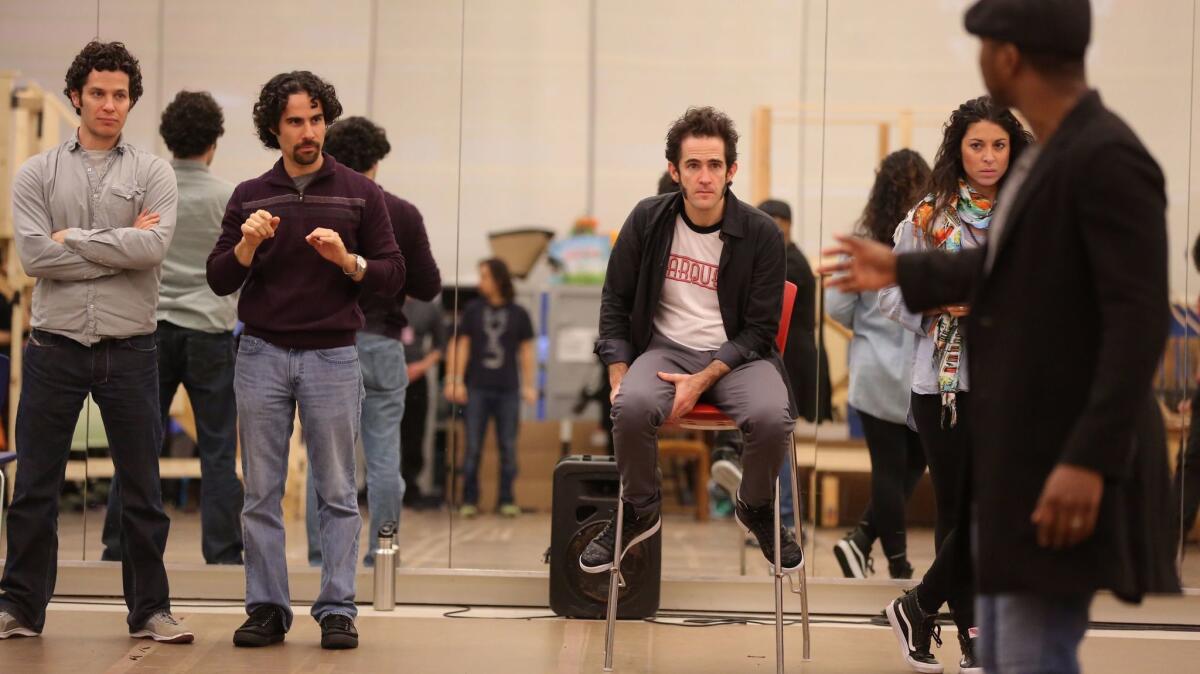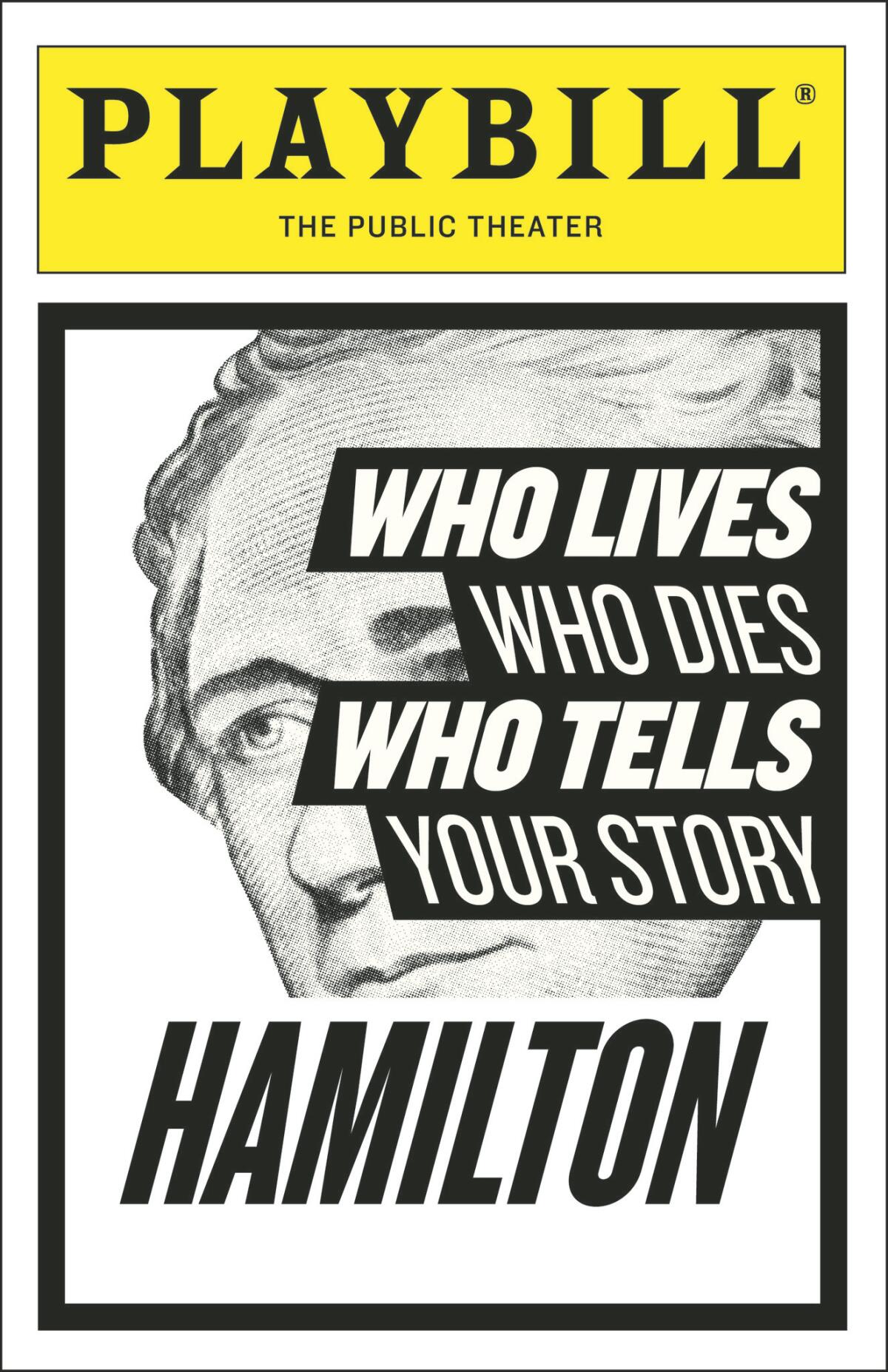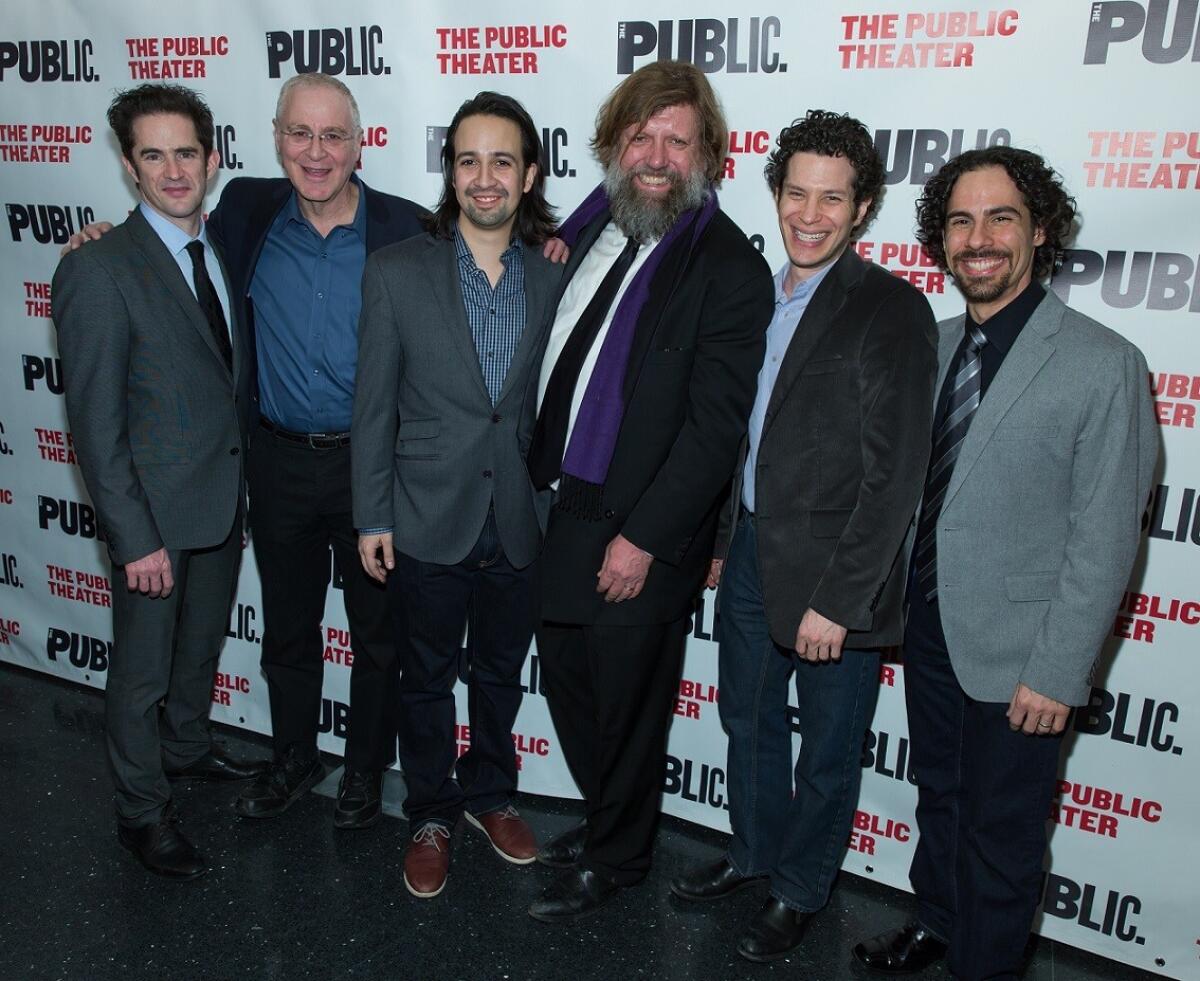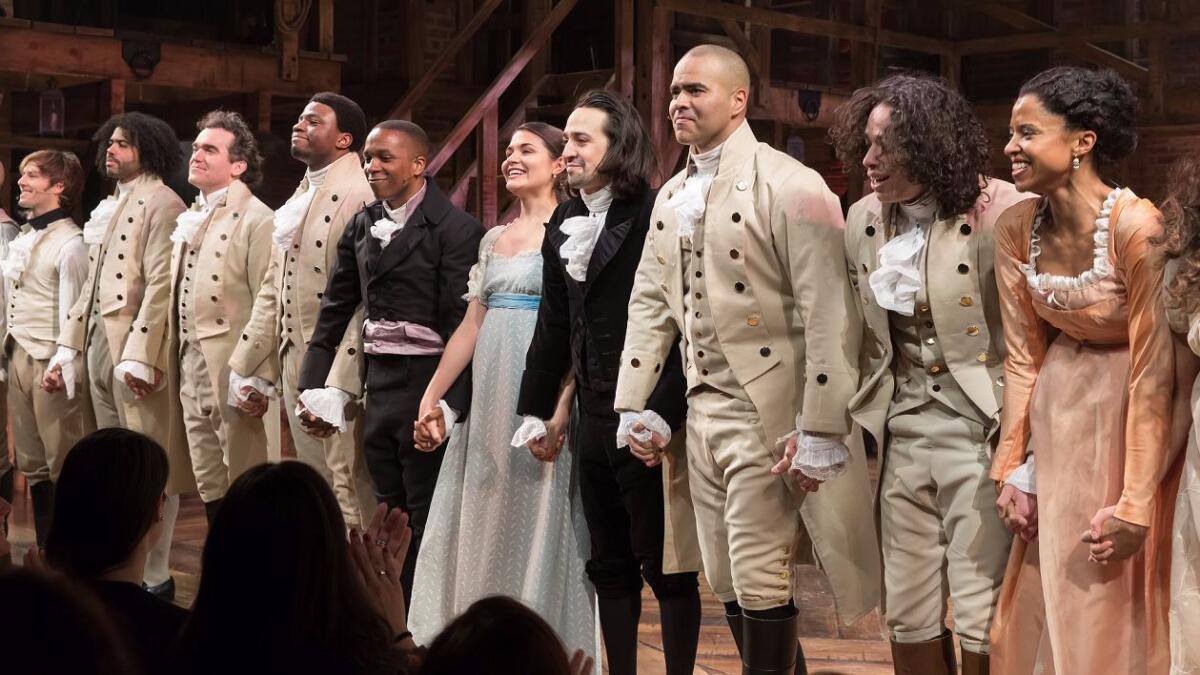The birth of ‘Hamilton,’ told by the man who was in the room where it happened
- Share via
In May 2009, my friend Jeremy McCarter made me sit down and watch a video of the now-famous rendition
The song pierced me, thrilled me and converted me. I had been completely oblivious to the size and scope of Lin's genius, and in 4 minutes and 32 seconds I was awakened from my dogmatic slumbers. It was immediately apparent that Lin had hit upon a subject and a form that were brilliantly suited to each other. By reimagining the birth of our nation through a Founding Father who was a bastard immigrant orphan from the West Indies, a self-made man who not only preached independence but manifested in his life the freedom and possibilities that America allowed, Lin was putting the revolutionary back in the American Revolution. By using the language of the streets to tell the story of our country, Lin was reclaiming that story as a tale that belonged to all people, not just the powerful. By writing with wit and irreverence about a subject obfuscated and ossified in the history books, he brought the tumult of the late 18th century to contemporary life.
What followed, for me, was three years of trying to convince Lin to come work on “Hamilton” at the Public Theater, where I have been artistic director since 2005. His initial strategy for deflecting me was simple: "It isn't a show, it's a concept album. Maybe the show will come after the album?" I thought this was a line developed for the sole purpose of putting me off. Later I recognized a deeper truth: It was a way for Lin to keep his voice free, his impulses open, without having to feel the pressure of writing a book for a musical. As long as they were just songs, there was no obligation to link them all seamlessly in the telling of the story.
So I kept inviting Lin, Lin kept writing songs, each more brilliant than the last. (I remember literally screaming the first time I heard Lin's demo of “Helpless.”) The world began to slowly hear more of “Hamilton.” American Songbook at Lincoln Center presented an evening of Lin that included 12 songs from “Hamilton,” then still called “Hamilton Mixtape”; New York Stage and Film at Vassar did a workshop of what became the first act. Gradually it became clear to Lin, and to all of us, that this was indeed a show. A musical. And after a series of conversations, Lin agreed to come to the Public Theater to develop and premiere the show.
I believe he chose the Public because it was the right place to nurture this extraordinary musical into life. It is a civically engaged theater deeply committed to the idea that the culture belongs to everyone, and that the brilliance of America is in its deep democratic inclusivity. We give away 100,000 free tickets every year to Shakespeare in the Park; we have developed groundbreaking theatrical work by giving center stage to those who have been denied their place in the American story, we insist that the theater has something to offer to the great debates of our time.
And we've got a pretty good track record of developing and producing bold musicals, from “A Chorus Line” to “Caroline, or Change” to “Fun Home.”

The structure of the first act was always clear, indeed laid out in that very first song Lin wrote, which gets Hamilton from birth to New York City; the rest of the act brings us to George Washington appointing him to be the first secretary of the Treasury. We could have taken an act break after the winning of the Revolutionary War, and certainly “Yorktown” felt like a fantastic first act curtain, but it was clear we needed to set up the stakes for the second act before letting the audience go. The first act was creating a nation; the second act would be building a nation.
The structure for the second act was much less obvious. Ron Chernow had narrated Hamilton's life in his magisterial biography, and his book provided a powerful spine for the action. Nonetheless, the show needed to focus on the dramatic journey at the heart of our hero's tale, and formulating that dramatic action correctly was our most important task. For me, the most successful articulation was this:
Hamilton is driven by both personal ambition and by idealism, and for most of his life the two were inseparably intertwined. When public disgrace and personal tragedy seem to overwhelm him, he must choose between his own interests and the good of the country. At the cost of his own life, he chooses his country.
One of the great gifts of the show, and one of the reasons audiences have responded so rapturously, is that “Hamilton” unleashes our often-dormant patriotism. It allows progressives to unashamedly love America.
We knew Hamilton's story ended with his death, as our musical must. The show begins with Hamilton announcing "I am not throwing away my shot"; it ends with him doing exactly that. No one knows precisely what was in Hamilton's mind during his fatal duel with Aaron Burr, and Lin struggled with Hamilton's final words until very late in our process. In my often simplistic way, I was pushing him to answer the question of what Hamilton was thinking; rather than providing a definitive answer, Lin brilliantly made Hamilton's uncertainty the heart of his final speech.

Years before “Hamilton” opened at the Public on Feb. 17, 2015, I had been comparing Lin to Shakespeare. Each of them took the language of the common people and elevated it into verse, thereby ennobling both the language and the characters who spoke it. They both told the founding stories of their nation in a way that recognized everyone, of all classes, as citizens. They both employed a freedom of form that was exhilarating and masterful.
But Shakespeare and Lin also refused to be completely pinned down, leaving their narratives open to interpretation and constantly renewed debate. Leaving them, in short, entirely human.
Lin gathered around him an amazing group of collaborators, each of whom was essential to this show.
Alex Lacamoire, orchestrator and music director, the curly-haired cherub I saw at the piano in that first clip of Lin at the White House, is not only a brilliant musician but a deeply loving collaborator. He shares so much musical DNA with Lin that he was able to express all the diverse musical influences of the music while always making it feel like one score.
Andy Blankenbuehler’s choreography adds a dimension to Hamilton that I've never seen before — a form of abstract but profound narrative that continually supports and enhances the story. His dancing dramaturgy would become a profound piece of the show.
Jeffrey Seller is the commercial producer who has been attached to Lin and his work for Lin's entire career. I would come to treasure Jeffrey as a partner: His brilliant commercial instincts were matched by his deep commitment to supporting the show in becoming the best possible version of itself.
And guiding the entire ship was Tommy Kail, Lin's friend, fellow Wesleyan graduate and the director of “Hamilton.” It was with wonderment and awe that I watched Tommy direct. I have never seen a director more able to inspire the best possible work from everyone around him, more willing to let the best idea win in any debate, more able to lead from vision and principle. He is a miracle.
Obviously, there were many other vital contributors to this show, but it was these four, along with Lin himself, who were the leadership. I was privileged to be among them.

SIGN UP for the free Essential Arts & Culture newsletter »
The story of “Hamilton’s” opening at the Public, the enormous acclaim with which it was greeted, and its subsequent move to Broadway and transformation into a cultural icon, was extraordinary, full of countless joys and drama.
We played “Hamilton” in the same theater where “A Chorus Line” had opened 40 years before. At a time when America was suffering desperate unemployment, “A Chorus Line” was the magnificent musical about needing a job; it ran for 16 years on Broadway. It spoke to its time as powerfully as “Hamilton” speaks to our multicultural America. In April 2015, on the 40th anniversary of the opening of “A Chorus Line,” we brought the original cast back to the Public to watch “Hamilton” At the end of the show, the chorus of “Hamilton” serenaded the original company of “Chorus Line” with "What I Did for Love."
First Lady Michelle Obama came to the show at the Public. As I was walking her down to the Green Room to meet the cast, she said to me, "This is the greatest work of art I have ever seen, in any medium." My joy was immediately tempered by my crushing realization that I was the only one who had heard her say it. But a year later, when the entire company were guests of the Obamas at the White House, she said it again, word for word, on national TV.
On that same trip, I had the joy of watching Chris Jackson, our brilliant original Washington, sing “One Last Time” directly to President Obama, less than a year before Obama would leave office. There was not a dry eye in the room, and when the president thanked us, he finished by saying, "Let's teach ’em how to say goodbye."
“Hamilton” is a brilliant musical, and a brilliantly entertaining one. But it is more than that because it was created by the huge and generous hearts of the artists who made it, most of all Lin himself. Broadway musical numbers, hip-hop and Beatle-esque ballads all seem to belong together, because they are all things Lin loves. In that way, the form of this amazing musical manifests the egalitarian angels of this country. It doesn't just speak of a nation where we all belong; it creates it onstage. May it inspire all of us to make our country as good as “Hamilton.”
Find all of our latest “Hamilton” national tour news at latimes.com/hamilton.

Support coverage of the arts. Share this article.
MORE ‘HAMILTON’:
Timeline: From Mixtape to musical and more
A critic’s take on why ‘Hamilton’ matters more than ever
Behind the scenes of the national tour
Tickets: The $10 lottery and other ways to score seats
Meet Aaron Burr: Why ‘Hamilton’ brings actor Joshua Henry to tears
Meet Angelica Schuyler: How Emmy Raver-Lampman rose into the spotlight
The biggest entertainment stories
Get our big stories about Hollywood, film, television, music, arts, culture and more right in your inbox as soon as they publish.
You may occasionally receive promotional content from the Los Angeles Times.







